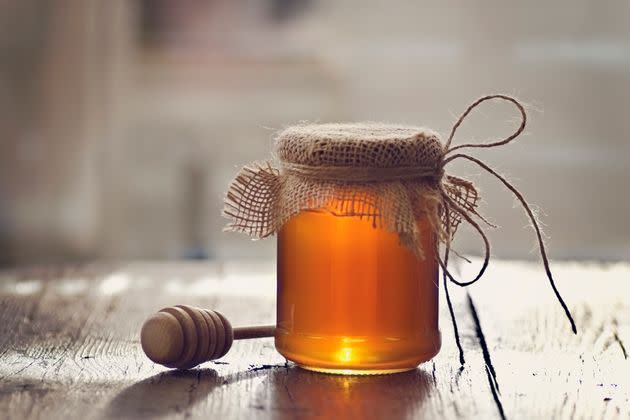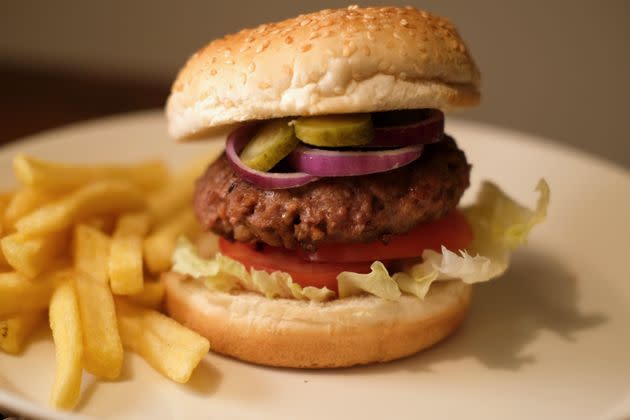6 Things You Should Know Before Going Vegan

Switching to a vegan diet requires some preparation, but cutting out animal products also comes with upsides for your health.
For the last decade, the grassroots Veganuary initiative has encouraged people to try out a vegan diet for a month, whether it’s intended as the start of a permanent lifestyle change or just a little challenge to bolster your Meatless Monday cooking skills for the rest of the year. This month, hundreds of thousands of people around the world will give veganism a shot, if recent years are any indication. If you’re one of them, welcome to the fold!
Animal agriculture is one of the biggest man-made contributors to climate change, and a major dietary shift could help prevent some of the worst projections scientists have made for the planet’s future. Our animal-reliant global food systems are the single greatest factor behind biodiversity loss. And, of course, there’s the even more immediate issue of animal suffering. Most American consumers know their eggs are more likely to come from a block of battery cages than Old MacDonald’s sunny farm, that live baby chicks are ground up as a waste product and that animals thought to be capable of emotion and social connection, not unlike our own pets, can be subjected to horrific levels of pain and fear. Amid all this, we as individuals can still make a difference — simply by changing what’s on our plates.
But no matter how compelling your reasons, any major lifestyle change can be daunting. Going vegan, in particular, is often cast as risky — a diet that, even if you somehow stick to it, will just land you in the hospital for malnutrition. But to me, someone who’s been managing as a vegan for over a decade, this premise is laughable. If you’re underprepared, you’re probably not going to have a very easy time. But fortunately, that’s not who you are — you’re reading this article, after all. Here’s a little crash course, with tips from nutritionists and my own experience.
1. First, know that the vegan diet isn’t right for everyone.
“Following a vegan diet may be more challenging for someone who already requires other dietary restrictions,” said Alexa Bickhart, a registered dietitian at NewYork-Presbyterian/Weill Cornell Medical Center. For example, Bickhart said, veganism might be ill-suited to celiac disease patients, who must strictly avoid gluten, or those with digestive issues who can’t tolerate high-fiber diets. Even people who just strongly dislike a number of plant foods might have trouble eating a balanced diet while vegan.
And though there are plenty of perfectly healthy reasons to go vegan, you are still cutting something out of your diet. Practicing food restriction in any form can be sticky for those who have a history of disordered eating, opening the door to more destructive thoughts or behaviors.
“There is also the possibility that dietary restrictions associated with a vegan diet may promote or reinforce disordered eating patterns for some people, which would also prevent this diet from being a healthy choice for them,” Bickhart said. If you have any physical or mental conditions that might complicate a monthlong cold-turkey dietary change, you may want to reconsider — or at least make the transition under the care of appropriate medical, nutritional and behavioral health professionals.
2. It requires a lot of label education.
If you’re someone without allergies or other restrictions and can more or less eat whatever you want without worrying, you’ll probably need to get into the habit of studying labels and looking up recipes whenever you can. So much of the food we eat contains a laundry list of ingredients, and it’s not always obvious which ones are vegan-friendly and which ones aren’t. Whey, gelatin, rennet and ghee are all animal products commonly used as food additives; lactic acid, despite what the “lac-” prefix might make you think, is present in many plant-based foods.

Honey is an everyday ingredient that many people don’t realize isn’t vegan.
This might sound like a herculean task, but you’ll start to recognize brands and broad categories of product that you know are vegan, and with some time you’ll be able to scan a nutritional label in just a few seconds. (Pro tip: Many common animal products are also major allergens, so they’re announced in bold after the full ingredient list, i.e., “Contains: Egg, Milk.”)
3. Know that a vegan diet isn’t necessarily healthy — or unhealthy.
There are all sorts of compelling health-related reasons to avoid animal products — consuming red meat and processed meat products has been linked to certain kinds of cancers, vegan diets are associated with lower risks of dying of heart disease and there’s evidence to suggest that plant-based eating can help prevent and manage Type 2 diabetes. But cutting out foods is only as healthy as whatever you’re replacing them with.
According to Bickhart, a vegan diet would ideally “emphasize whole foods like fruits, vegetables, whole grains, nuts and seeds, and legumes.” But, she said, “a diet consisting of only French fries and soda would also technically be considered vegan,” and you’d be unlikely to reap many health benefits.
That said, it’s a myth that vegan diets can’t be nutritious, dietitians told me.
Notably, a recently published observational study on Veganuary participants found that those who were going from an omnivorous diet demonstrated a significant drop in their intake of saturated fatty acids and cholesterol (which is likely good for cardiovascular health, though the jury is still out on exactly how good). But they also had a sudden drop in their intake of a number of micronutrients, especially vitamin B12 (more on that later). Nutritional science is much too nuanced to accurately say a vegan diet is, in broad strokes, healthy or unhealthy.
“You can absolutely get a balanced nutritious diet and meet all of your nutrient needs with a vegan diet,” Samantha Pyser, a registered dietitian at NYC Health + Hospitals/Lincoln, told HuffPost. Protein in particular tends to be an element of concern for vegans, but as Pyser explained, “there are many, many sources of plant protein,” ranging from tofu and tempeh to hummus, lentils and beans. Of the nine amino acids that mammals need to eat for survival, all are available in plants. And if you’re wary of tofu or tempeh for fear that the soy will mess with your hormones, you probably don’t need to be. Unless you have an allergy or your doctor has advised you to avoid it for another reason, Pyser said, there’s ample, trustworthy clinical evidence that “people who eat soy on a regular basis are healthier than those who do not.”

Plant-based burgers are often made with so many additives that they’re not necessarily healthy.
In Pyser’s opinion, the average person, vegan or not, really doesn’t need to get caught up in measuring macronutrients or counting amino acids — what’s more important is focusing, big-picture, on a balanced and varied diet.
4. Don’t get stuck in a salad trap.
Listen, food is good. It tastes good, and enjoying it is one of the purest, most basic pleasures afforded to us living beings. For most people, eating one single meal over and over, no matter how nutritionally complete it may be, is going to get boring. If you don’t have at least a small rotation of recipes (or even prepared foods) that you like, it’s going to be a lot harder to resist grabbing a juicy cheeseburger on your way home from work. Expect to teach yourself a few new recipes and know where you can get (or how to make) a little pick-me-up if you need it.
That is to say, don’t just swap all your meat and cheese for leafy greens and expect to feel good. You’ll need to figure out how to satiate yourself on a plant-based diet, which may mean experimenting with bigger portion sizes or adding in foods you’ve never tried before. Any diet that leaves you still hungry or otherwise unsatisfied is doomed to failure.
There are about a billion healthy and delicious vegan recipes across the internet, but for those looking to make a big dietary change, little rules of thumb can be helpful. Pyser and other lifestyle medicine practitioners within the NYC Health + Hospitals system instruct their clients to build “plant-powered plates” that consist of 1/4 plant protein, 1/4 starch or grain and 1/2 non-starchy vegetables, plus one to two servings of a healthy fat, such as nuts or avocado. It’s a simple formula to ensure you’re getting balanced meals while leaving you plenty of flexibility to try new flavors and celebrate your old favorites.
5. Take your supplements.
These days, a lot of our foods, especially plant milks, are fortified with vitamins and minerals. But for some nutrients, your best bet will still be to take a supplement. Because vitamin B12 occurs naturally only in animal products, “people following a vegan diet are at high risk for a deficiency,” Bickhart said.
Vitamin D is another one that vegans (and actually anyone) might struggle to get enough of. Humans produce vitamin D endogenously when their skin is exposed to sunlight, but between the fact that many parts of the world don’t get much sun throughout the year and the harmful effects of UV rays, sun can’t be the only source of vitamin D for most people. Vitamin D also doesn’t occur naturally in very many foods, though dairy milk and plant milk alike are often fortified with it. Bickhart recommends asking your doctor to test your vitamin D levels to see if you require supplementation. f your doctor recommends you start taking vitamin D supplements, good news: There are vegan-friendly D3 supplements (the body’s preferred form of the vitamin) out there.
6. You’ll need to be flexible, or at least forgiving.
There isn’t one way to be vegan (although some would certainly tell you otherwise). Strictly defined, a vegan lifestyle is one lived without purchasing or consuming anything that results from animal suffering or exploitation — that means circuses, leather shoes, some fragrances and cosmetics, and even certain medications are verboten. But in reality, people practice different degrees of veganism.
For many vegans, it’s a dietary choice only, and even there they have some discretion. Processed cane sugar, for example, is often whitened through a process that uses animal bone char. Accordingly, some vegans won’t eat anything that contains cane sugar unless the brand explicitly states it is vegan-friendly. But not all vegans trace the entire supply chain of every single item they eat. Some vegans even eat honey and oysters. Where these lines fall, ultimately, is really up to you, your reasons for going vegan and what you’re able to manage as an imperfect person in this imperfect world.
It’s helpful to make these decisions ahead of time so you’re not left to face any major ethical decisions when someone passes you a tray of canapés. But wherever you set your own parameters, be gentle on yourself when you slip up. I say “when,” not “if,” because if you’re vegan for long enough, mistakes are inevitable. Whether you misread a label or just had a moment of weakness, one little blip doesn’t undo all the work you’ve done. Just by cutting meat, eggs and dairy out of your diet, you’re already making a difference.